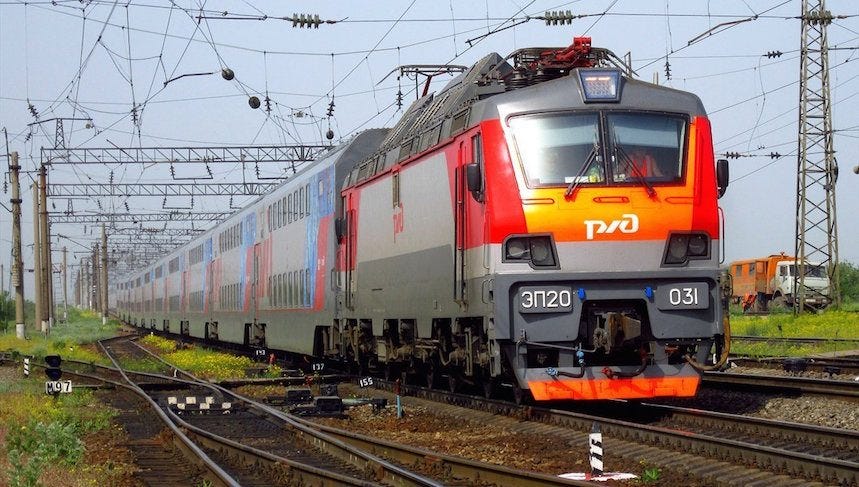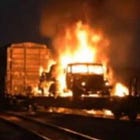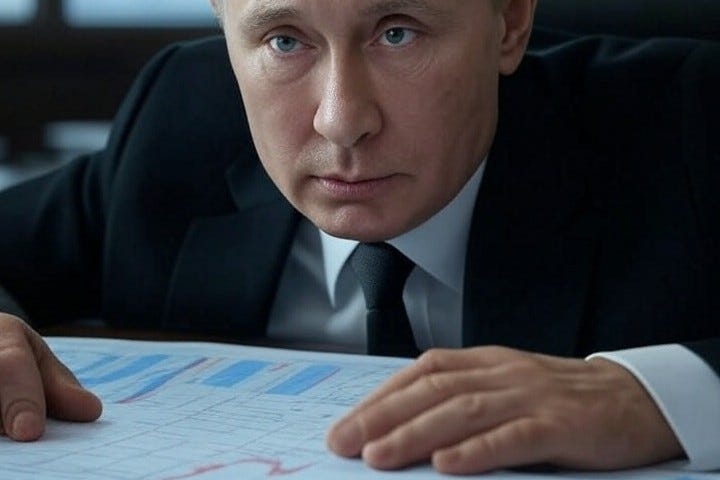
Russian business news website RBC is reporting that railroad employees in the heart of the country started taking two days’ unpaid leave per month in July because RZD, the state railroad company, is having trouble making payroll.
One anonymous source tells RBC “the decision is not formal in nature, concerns exclusively the company's management staff (central office and road departments), and does not affect blue-collar workers.” Another says that “a significant failure to present cargo” at the railhead is to blame.
RDZ wants “to increase fines for failure to present cargo on agreed applications tenfold” to stop their bleeding. “The amount of the fine has not been revised since 1998,” RBC reports. “Amendments to the legislation may be considered in the State Duma during the autumn session.”
“Net profit fell 95% to 2.7 billion rubles ($33.8 million) in the first half of 2025, according to Russian Accounting Standards,” The Moscow Times adds. “The rail company now expects to lose 87 billion rubles (about $1 billion) in revenue this year as cargo volumes continue to slide.”
Net profits have vanished at RDZ. The real Russian economy no longer exists, so manufacturers are not shipping cargo. Already struggling to maintain a skilled labor force in a tight market, RDZ is now using furloughs to avoid bankruptcy.
The eyes of the world are on Donald Trump and Vladimir Putin this weekend, but the high-level diplomacy obscures a deteriorating situation inside Russia. An economy is a system of systems, and railroads are the connective system that links the entire Russian economy together. No railroads, no Russia.
The larger economic picture is all doom and gloom. “Russia's seven-month budget deficit exceeded the target for the entire year by a quarter, Finance Ministry data showed on Thursday, highlighting the strain of financing the war in Ukraine,” Reuters reported.
“The budget's oil and gas revenues — its most important source of cash, slated to account for about 22% of total revenues this year — fell by 27% in July due to lower prices and the strong rouble.” High inflation and slow economic growth have produced a long-term state of stagflation.
“Russia’s Central Bank cut the benchmark interest rate by two percentage points, to 18 percent, during a regular meeting” in July, down from the peak of 21 percent set in October 2024. Bank governor Elvira Nabiullina, who had set the higher rate to handle economic overheating, cited slowing economic growth for rate cuts she started making eight months after that peak.
Wartime spending has thus produced a clear boom-and-bust cycle in Russia. The real economy is in recession and even the wartime economy must reduce spending, according to Russians themselves at the recent St. Petersburg International Economic Forum.
Putin told that conference in June that a recession “must not be allowed to happen under any circumstances.” He wants a more “balanced growth,” meaning growth in terms of real-economy GDP, not just the stimulus effects of wartime spending. The tight monetary policy effectively ended all commercial lending and investing in Russia.
Without revenues, businesses will not pay taxes. Without wages, workers will not pay taxes, and new tax revenue was supposed to make up a substantial part of the new budget. The Kremlin sacrificed consumer sectors of the economy, especially the consumer financial sector, to pay for the war.
Russian consumers have consequently stopped spending their money, preferring to keep it in their high-interest bank accounts; stopped paying their loans and credit cards; stopped taking out mortgages or buying cars. The banks are talking about bailouts by 2026. They will have to join the queue with RZD.
Meanwhile, Putn’s most loyal gold mining oligarch has been detained, his fortune and company confiscated. Konstantin Strukov is being charged with corruption at Uzhuralzoloto (South Ural Gold).
It bears mention that Putin is a goldbug. He wants gold to replace the dollar as the global reserve currency — which is frankly impossible, there is not enough gold in the world — but more to the point, gold reserves are his key hedge against international sanctions.
For similar reasons, Putin has followed a policy of state ownership stakes in various high-value extraction industries, such as diamond mining, from right around the time his controntationalism with the West began.
The reader will by now be familiar with the impressive number of Russian oil and gas executives who die from defenestration, that is, falling (or being made to fall) from apartment balconies and other convenient high places. Without accounting for individual cases, these stories represent the rolling-up of oligarch fortunes and state-level enterprises and their repurposing into the uses of the state.
“Putin will stop killing people if you get energy down another $10 a barrel,” Trump says. He means Ukrainian people, of course, but Russian blood is fueling the war, too. As long as there are Russians willing to sign contracts, the war goes on.
Putin still has the last liquid dregs of the Russian National Wealth Fund left; he has a banking system that still has room to leverage; he can further cut the social welfare and infrastructure of the state. He does not think of himself as broke, yet. Gamblers never do.
Trump says that the Russian economy “stinks” but this is a vast understatement. A report this week by the Center for Macroeconomic Analysis and Short-Term Forecasting, a Kremlin-backed think tank, says that GDP should hit zero by the end of the year.
“Improvement is unlikely,” Per Anders Åslund of the Atlantic Council writes. “The country’s financial reserves are running out, energy revenues are declining, and there are increasingly severe shortages” of consumer goods, the cargo that was never delivered to the railhead, so that RZD trains could not carry it and get paid.
According to an investigative report by Novaya Gazeta Europa, “abandoned frieght trians” have become common on Russian railways. “Thousands of cars stopped moving for weeks” beginning last year. “Sometimes the trains remained in the ‘abandoned’ status for several months.”
“It was the priority of military cargo that became one of the important reasons for the decline in loading by rail” across the system, the report says. “It turns out that military transportation clearly does not compensate for the decline in other goods, and this is directly reflected in the financial position of the railway.”
There are not enough workers or locomotives, so excess rolling stock ends up scattered all over the place, a situation that is “more bad than good,” Novaya Gazeta Europa says. In the railroad industry, this leads to a logistical snarl called the ‘wagon loop.’
Because “there are not enough wagons in one place, shippers increase their fleet — they buy or rent, and then Russian Railways cannot cope with the delivery of ‘empty’ cars. It clogs the tracks, and then even more wagons are needed to carry the cargo,” the report explains.
"Somewhere at the stations, cars accumulate, traffic becomes difficult, as a result, the delivery speed drops, the travel time increases. In order to fulfill contractual obligations, the fleet is further increased, which stimulates a new circle of network slowdown," explains Polikarpov from Rollingstock Agency.
He considers the situation critical. And Russian Railways agrees with him, because, according to the state corporation, as of March 2025, 300 thousand unclaimed cars had accumulated on the tracks - this is almost a fifth of the entire fleet (1.39 million units). These are thousands of abandoned trains that stood for weeks, paralyzing traffic.
Russia cannot build enough locomotives to make up for imports lost to sanctions. According to Novaya Gazeta Europa, “everyone expects that this deficit will only grow: in January-April 2025, the production of mainline electric and diesel locomotives fell by 13 and 6%, respectively.”
Already a state-owned company, RZD will need a bailout in 2026. But even money cannot solve what is really wrong with Russian railways. The war itself is doing this. At this point, however, the economy would crash if the war spending stopped. Like the proverbial shark that must continue to swim at all times or die, Putin cannot agree to meaningful peace, right now.
First, he must get some sort of “balanced growth” and keep his banking system stable in an environment of vanishing consumer and business credit. Companies with state favor, mainly defense-related ones, will enjoy good access to credit. Everyone else will see interest rate cuts from 21 percent to 18 as no reason to start a business or take out a loan.
Putin cannot have peace without a soft landing. He needs time. Pay no attention to the diplomatic dance this weekend. Peace is not happening. Rumors of peace are misleading. Putin needs time to prepare that soft landing, and it’s already a dicey prospect.
No railroads, no Russia. Sensing the vulnerability, Ukraine has redoubled the intensity of their campaign against Russian rail systems supplying the front. Tatsinskaya railway station in Russia's Rostov Oblast was struck multiple times this week, including a train of fuel tankers. Regional airports and mobile services were shut down by the drone alerts.
According to Militarnyi, “due to its double-track layout, high transport volumes, and critical infrastructure (including an oil depot and grain elevator), the station is considered a logistically important point for supplying military resources” in the Ukraine theater.
But the breakdowns that matter are happening far from the battlefield. “Russia’s efforts to establish a self-sufficient aircraft manufacturing industry are faltering as domestic companies face persistent shortages of components and a steep decline in engineering capacity,” Anatoly Gaydansky, CEO of aircraft parts manufacturer Aerocomposite, told Russian media last month.
Gaydansky cited two vital underlying industries, “the electronic component base” and heavy roller ball bearings. Trains and railroads can be entirely computerized these days, but they existed before microchips, whereas heavy roller ball bearings have always been essential for both airliners and railroads.
Similar economic conditions prevailed when the state of the railroads in Russia led to the collapse of the Russian state and the rise of the Bolsheviks. A shortage of labor, especially skilled labor, and the shutdown of essential industries by strikes, as well as mismanagement of the railroads by communists who knew nothing of railroad management, created episodic famines.
History is rhyming. In a separate report during May, Novaya Gazeta Europa warned “this year there will be a new jump in bread prices” in Russia, mainly due to labor costs and “raw materials,” meaning wheat. A drought has afflicted key grain-growing regions, but it is made infinitely worse by Kremlin export duties meant to protect domestic consumers.
Those measures have instead “devastated the finances of the agricultural sector,” which had been an export industry, and “farmers are trying to compensate on the domestic market for what they did not receive on the foreign market.” There is less grain, for the economic burdens have been laid on “agricultural producers” in the usual Russian style.
At the same time, flour was not subject to the export duty, creating “an imbalance” that raised exports and domestic prices. Putin’s Russia begins to resemble previous iterations of Russia as “the profitability of grain growing was also hit hard by the clumsy attempts of the authorities to stop buying seeds abroad and switch to ‘import-substituted’ ones.”
“The main problem with Russian crops is that their yield is almost half that of imported grain hybrids,” Novaya Gazeta Europa explains in a story as old as Russia. The rising costs of fertilizer — another product prioritized for export, driving up domestic prices — as well as other chemicals, and the fluctuations of the ruble, all impact production costs.
Forced to use twice as much labor planting and harvesting twice as much land to get the same yield, when there is a labor shortage due to the war, producers have no choice but to raise prices.
Or, they can simply cut their investment in production. “Sales of combine harvesters dropped by 76%, forage harvesters by 49% and articulated tractors by 48% from January-April 2021 to January-April 2025,” according to Rostselmash, Russia’s biggest maker of agricultral machinery.
The Kremlin tried to fix the decline of its agricultral sector with subsidies. State support for farmers is disappearing now, however, just like the rural males who used to do the seasonal farm labor in Russia have all disappeared. Russia can import labor, of course, but this is always controversial.
Despite the high labor shortage and falling profitability of agriculture, in 2024, the authorities, on the wave of an anti-migrant campaign, banned foreigners from working in the most agro-industrial regions - Krasnodar Krai and Astrakhan Oblast. In the latter, however, they are already clutching their heads, having discovered that there is no one to work, and are going to let foreigners into the fields again.
Most telling of all, Novaya Gazeta Europa says, are the massive land seizures of once-privatized or purchased state lands. “Dmitry Patrushev Jr. (now the Minister of Agriculture) headed Rosselkhozbank in the 2010s, which, after the start of the war, has been actively acquiring agricultural enterprises and food producers,” they note.
“Another influential group that is very interested in agricultural assets is the family of Putin's old acquaintances, Arkady and Boris Rotenberg.” The Russian oligarchy eats itself to survive while the Russian state rolls up old real estate.
The re-Sovietization of the Russian economy is in full swing. “Amid high inflation, Russia is preparing to cap prices on staple food items, a move analysts say signals a shift toward a command economy that could trigger shortages, long queues, and public discontent,” the Kyiv Independent reported last week.
Altogether, “80–90% of food production would be sold through long-term contracts at fixed prices, or within government-mandated price ranges” under draft regulatory amendments reportedly being prepared by the Agriculture Ministry and Industry and Trade Ministry.
While the move is seen as a necessary step to curb inflation, economists warn that the consequences may mirror the failures of Soviet-era central planning.
"Russia is now shifting toward a fully planned, command-style system, with all its usual flaws — constant food shortages, long queues, and everything else that comes with it," said Igor Lipsits, a Russian-born economist.
"That's what lies ahead for Russians, and it's becoming quite clear."
As things fall apart, Russia reverts to modes of distribution that Russians thought they had left behind forever. Vladimir Putin wanted to restore the sense of awesome power and limitless ambition that Russia enjoyed in the Soviet era of his youth. He has instead restored the worst impulses of imperial Russia at the center, producing similar faults, affecting systems of systems in similar ways.
Inefficiency, endemic corruption, and the restoration of Soviet economy will deter foreign investment capital even in the event of a swift return to peace. Since 2022, spare parts, ball bearings, etc. could be accessed from a global market through neutral countries, but only at increased expense.
Russia has failed to create a macroeconomic autarky that can sustain a long, high-intensity conventional war without imports. That, too, is a very Soviet failure.
Putin's War Will Turn On Macroeconomics
Wars are fundamentally macroeconomic affairs. Soldiers are labor, conscription is a form of taxation, production and demand set prices. Men with guns and gold win wars. The larger macroeconomic alliance will have the advantages of greater collective GDP, and will therefore most likely win.



